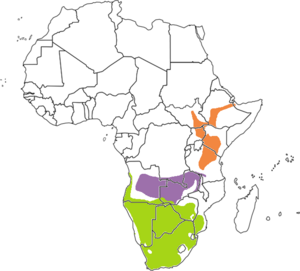Acacia pied barbet
Quick facts for kids Acacia pied barbet |
|
|---|---|
 |
|
| Widespread subspecies T. l. centralis in the Hardap Region of Namibia | |
| Conservation status | |
| Scientific classification | |
| Genus: |
Tricholaema
|
| Species: |
leucomelas
|
 |
|
| Tricholaema diademata
Tricholaema frontata Tricholaema leucomelas |
|
| Synonyms | |
|
|
The acacia pied barbet or pied barbet (scientific name: Tricholaema leucomelas) is a cool bird found in southern Africa. It belongs to the Lybiidae family, which includes other barbets. This bird is known for its striking black and white stripes, especially on its head!
Contents
About the Acacia Pied Barbet
What's in a Name?
The acacia pied barbet was first described in 1780 by a French scientist named Georges-Louis Leclerc, Comte de Buffon. He studied a bird from the Cape of Good Hope in South Africa. Later, in 1783, a Dutch naturalist named Pieter Boddaert gave it the scientific name Bucco leucomelas.
Today, this bird is placed in the genus Tricholaema. This name was created by French brothers Jules and Édouard Verreaux in 1855. The name Tricholaema comes from Ancient Greek words: thrix means "hair" and laimos means "throat". The second part of its scientific name, leucomelas, also comes from Ancient Greek. Leukos means "white" and melas means "black". So, its name basically means "white and black hair-throat"!
Different Types of Acacia Pied Barbets
There are three main types, or subspecies, of the acacia pied barbet:
- T. l. centralis (named by Roberts in 1932) – You can find this one from Angola to western Zimbabwe, and south to Namibia and northern South Africa.
- T. l. affinis (named by Shelley in 1880) – This type lives in eastern Zimbabwe, southwest Mozambique, and northeast South Africa.
- T. l. leucomelas (named by Boddaert in 1783) – This is the original type found in southern South Africa.
What Does It Look Like?

The acacia pied barbet has dark brown eyes and blackish legs and feet. Its head is striped black and white. It has a bright red patch on its forehead and a pale yellow stripe above its eye.
Under its chin, it has a black patch, like a bib. Its chest and belly are usually white. However, some types have slightly different colors. The birds living in drier areas (T. l. centralis) have whiter undersides. Those in the south have more streaky, dusky undersides. The ones in the east have a yellowish tint.
Male and female acacia pied barbets look very similar. Young birds don't have the red patch on their forehead yet. Their underparts are also more streaky.
Where Does It Live?
The acacia pied barbet mostly lives in dry savanna areas. You can also find it in grasslands, fynbos (a type of plant community), farm areas, and even city gardens. It didn't always live in gardens, but it has moved into these areas. This happened because new plants, especially Racosperma species from Australia, were brought to areas near its original home. These new plants helped the bird spread to places it couldn't reach before.
You can find this bird in many countries in southern Africa, including Angola, Botswana, eastern Eswatini, western Lesotho, southern Mozambique, Namibia, South Africa, southern Zambia, and Zimbabwe.
How Does It Live?
Daily Life
The acacia pied barbet usually stays in one area. However, it's a pretty active bird. You'll often see them alone or in pairs. When they fly, they move fast and in a straight line.
Nesting and Eggs
Like most other barbets and woodpeckers, the acacia pied barbet makes its home by drilling holes into dead wood. These holes become their nests. The female bird usually lays two to four eggs between August and April. Both the male and female birds take turns sitting on the eggs to keep them warm until they hatch.
What Does It Eat?
The acacia pied barbet eats a variety of foods. They have been seen eating fruit from different trees and shrubs, like Ficus and Searsia. They also enjoy nectar from Aloe plants and, of course, insects!


